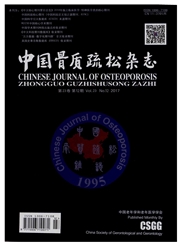

 中文摘要:
中文摘要:
目的分别评估亚洲骨质疏松筛查工具(OSTA)及上海市绝经后妇女低骨量简易筛选方法(STLBMS)与上海市绝经后妇女骨密度及椎体骨折的关系,并比较两种筛选方法对骨质疏松和椎体骨折发生的预测能力。方法共入选988例绝经后妇女,有或无脊椎压缩性骨折各494例。两组均用双能X线吸收仪检测腰椎和股骨近端骨密度,并计算OSTA与STLBMS指数。结果两种筛选法均显示骨折组风险指数更高(P〈0.001);在两组中分别比较两种筛选法,均显示STLBMS法的风险指数更高(P〈0.001)。OSTA与STLBMS指数与骨密度均正相关(r=0.336~0.562和r=0.383~0.570,P均〈0.001);而两种筛选指数间呈显著正相关(r=0.974,P〈0.001)。以OSTA≤-1和STLBMS≤5为分界点,OSTA与STLBMS法诊断骨质疏松的工作曲线,曲线下面积(AUC)分别为0.73和0.74;在预测椎体骨折方面,OSTA与STLBMS法的AUC分别为0.55和0.57。结论OSTA和STLBMS筛选法均与骨密度呈显著正相关,也有助于椎体骨折的发现,两种方法对骨质疏松和椎体骨折发生的预测能力没有统计学差异,是理想的骨质疏松筛选工具。
 英文摘要:
英文摘要:
Objective To estimate the relationship of the Osteoporosis Self-Assessment Tool for Asians (OSTA) and a simple screening tool for low bone mass of Shanghai (STLBMS) with bone mineral density (BMD) and vertebral fracture in Shanghai postmenopausal women. We also compared the ability of these two screening tools to predict osteoporosis and vertebral fracture. Methods 988 postmenopausal women were included: 494 with vertebral fractures and the other 494 without. BMD at spine and proximal femur were measured by dual-energy X- ray absorptiometry. OSTA and STLBMS indices were calculated. Results Both indices demonstrated that the fracture group had higher risk indices( P 〈 0.001 ). Both groups showed that higher risk indices with STLBMS index( P 〈 0.001 ). BMD at the L1_4 and proximal femur showed positive correlation with OSTA and STLBMS index (r = 0.336-0.562 and r = 0.383-0.57, all P 〈 0.001). These two methods correlated more significantly( r = 0.974, P 〈 0.001). The OSTA values of ≤ - 1 and STLBMS values of ≤5 could diagnose osteoporosis with an area under curve (AUC) of 0.73 and 0.74. They could predict postmenopausal vertebral fracture with an AUG of 0.55 and 0.57. Conclusions We concluded that OSTA and STLBMS positively correlated with BMD and might be helpful to identify postmenopausal women increased risk of vertebral fracture. Our data showed no difference between the ability of these two screening tools to predict osteoporosis and vertebral fracture. Both of them were ideal tools for screening osteoporosis.
 同期刊论文项目
同期刊论文项目
 同项目期刊论文
同项目期刊论文
 Association of bone metabolism related genes polymorphisms with the effect of raloxifene hydrochlori
Association of bone metabolism related genes polymorphisms with the effect of raloxifene hydrochlori Association between myostatin gene polymorphisms and peak BMD variation in Chinese nuclear families.
Association between myostatin gene polymorphisms and peak BMD variation in Chinese nuclear families. A20 overexpression under control of mouse osteocalcin promoter in MC3T3-E1 cells inhibited tumor nec
A20 overexpression under control of mouse osteocalcin promoter in MC3T3-E1 cells inhibited tumor nec The change of hip axis length in 10384 males and females and the association with femoral neck fract
The change of hip axis length in 10384 males and females and the association with femoral neck fract Age-related changes of serum tartrate-resistant acid phosphatase 5b and the relationship with bone m
Age-related changes of serum tartrate-resistant acid phosphatase 5b and the relationship with bone m The identification of novel mutations in COL1A1, COL1A2, and LEPRE1 genes in Chinese patients with o
The identification of novel mutations in COL1A1, COL1A2, and LEPRE1 genes in Chinese patients with o ALOX12 polymorphisms are associated with fat mass
but not peak bone mineral density in Chinese nucle
ALOX12 polymorphisms are associated with fat mass
but not peak bone mineral density in Chinese nucle Polymorphisms in the HOXD4 gene are not associated with peak bone mineral density in Chinese nuclear
Polymorphisms in the HOXD4 gene are not associated with peak bone mineral density in Chinese nuclear Association between VDR and ESR1 gene polymorphisms with bone and obesity phenotypes in Chinese male
Association between VDR and ESR1 gene polymorphisms with bone and obesity phenotypes in Chinese male No association of the polymorphisms of the frizzled-related protein gene with peak bone mineral dens
No association of the polymorphisms of the frizzled-related protein gene with peak bone mineral dens Identification of novel mutations in WISP3 gene in two unrelated Chinese families
with progressive p
Identification of novel mutations in WISP3 gene in two unrelated Chinese families
with progressive p 期刊信息
期刊信息
